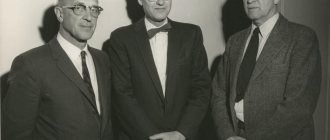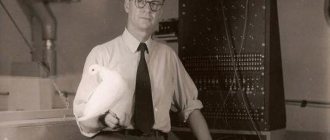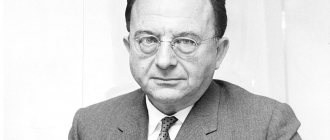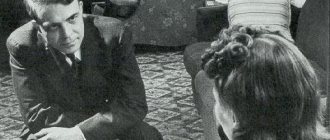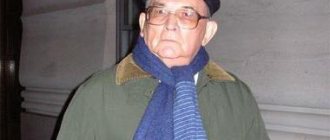«I have often seen people become neurotic because they were satisfied with insufficient or incorrect answers to the questions that life asked them. They were looking for success, position in society, a successful marriage, fame, but they remained unhappy and suffered from neuroses, even having achieved everything they had strived for. These people suffer from some kind of spiritual narrowness; their lives are usually poor and meaningless. Once they find a path to spiritual development and self-expression, neurosis usually disappears. That is why I have always attached so much importance to the very idea of personal development
", said Carl Jung.
Karl G y
becoming Jung - a Swiss psychologist, psychiatrist and philosopher, the founder of analytical psychology, the doctrine of the collective unconscious, the author of personality theory, dream theory, the associative method, personality structure, the concept of psychotypes, complexes, symbols and archetypes. Member of the Royal Society of Medicine of London, honorary member of the Swiss Academy of Sciences, honorary doctor of science from the universities of Oxford, Harvard, Calcutta, Benares and Allahabad.
Born on July 26, 1875 in the commune of Keeswil, in northeastern Switzerland. His father, Johann Jung, was a pastor of a reformist church, and his paternal grandfather and great-grandfather were doctors. Karl had a tense relationship with his father, who devoted more time to the study of classical sciences and the East. While her mother, Emily Preiswerk, often suffered from hysterical fits.
Unsociable, aloof and withdrawn, at the age of 10 he carved a 6-centimeter man from a wooden block picked up on the street. Often, climbing into the attic, he spoke to him in a secret language, when his mother’s fits and his father’s irritability brought him to the extreme of despair.
Biography
The author of the technique of free association, Swiss psychologist and philosopher Carl Jung is familiar to many from the books “Man and His Symbols”, “Archetypes” and “Memories, Reflections, Dreams”.
Jung's teachings are based on the terms "introversion" and "extroversion" that he personally developed. Karl argued that each individual, depending on the dominant personality function, can be turned either to his inner self (introversion) or to the external world (extroversion). Based on this conclusion, the researcher developed psychological types of people and derived a formula for the human soul, enclosing it in a psychiatric and psychological framework. Jung's work has had a significant influence on cultural studies, comparative religion, anthropology, pedagogy and literature.
Works
Associative method
Beginning with Freud's method of free association, which consists of naming associations in sequence, this method was abandoned when Jung noticed that people took longer to think about certain associations. Later, the meaning of precisely those associations that make you think for more than 4 seconds is analyzed.
Active Imagination Technique
Complexes are the consequences of mental trauma, which entail not only erroneous actions, forgetting important information, nightmares, but are also conductors of creativity. Art therapy allows you to directly interact with a person’s traits and collect into a single whole the fragments formed by psychological trauma.
Analytical psychology
Jung considers dreams as a breakthrough of the unconscious into consciousness, for example, a strong feeling that has been suppressed for some reason. Analytical psychology involves the interpretation of such dreams, as well as delusions and schizophrenic disorders, on the basis of associations, archetypes, and symbols.
Concept of psychotypes
Jung introduced such concepts as the main types of personality orientation: an extrovert, whose mental energy is directed outward, and an introvert, whose energy is directed inward. In his book “Psychological Types,” he cites as a possible explanation the mechanism of adaptation in animals: unlimited reproduction with a suppressed defense mechanism (extroversion) or a few offspring with excellent defense mechanisms (introversion).
Later, four main mental functions were added, which can also be directed outward or inward: thinking and feeling (rational) and sensation and intuition (irrational).
Jung also developed a questionnaire that allows you to determine your psychotype.
Personality structure
Jung's personality structure, also called the soul, consists of:
Ego
Awareness, the inner “I”, everything that a person recognizes as his own and associates with himself.
Personal unconscious
This is a personal experience that for some reason has been repressed from a person’s brain. Experiences that he has not yet realized. Everything that he does not remember and is not aware of, but which still affects him.
Collective unconscious
This is what Jung himself said about him:
«The collective unconscious contains the entire spiritual heritage of human evolution, reborn in the structure of the brain of each individual <...> The unconscious, as a set of archetypes, is the sediment of everything that has been experienced by humanity, right up to its darkest beginnings. But not as dead sediment, not as an abandoned field of ruins, but as a living system of reactions and dispositions, which in an invisible, and therefore more effective, way determines individual life
»
Red Book
This book records all the visions that Jung had. This is a product of the active imagination technique he developed. The visiting images “ brought me the understanding that in psychology there are things that I do not create, but which produce themselves and have their own little life
».
As well as many other articles and books.
Childhood and youth
Carl Gustav Jung was born on July 26, 1875 in the commune of Keeswil, located in northeastern Switzerland. The future psychotherapist's father, Johann Jung, was a pastor in a Reformed church, and his wife Emily was raising their son. As a child, Karl was an introverted and somewhat strange child. Unsociability and detachment appeared as a result of tense relations with the head of the family and frequent hysterical attacks of his mother, which Gustav repeatedly observed in childhood.
At the age of 10, Jung cut out a 6-centimeter man from a wooden block he picked up on the street, put him in a pencil case and took the craft to the attic. When the irritability of his father or the sickness of his mother brought the boy to extreme despair, he climbed into the attic and spoke in a secret language with a man-made friend. These oddities were the first manifestation of unconscious behavior, which Karl later described in detail in essays on the psychology of the unconscious.
The parents sent their son to the gymnasium when he was 11 years old. It is worth noting that Gustav showed no interest in either science or creativity. While the teaching staff complained about the lack of talent in the lack of initiative student, Karl, upon returning home, enthusiastically drew ancient castles and read prose. Karl could not make friends and express himself fully in his studies due to the feeling of dual personality that did not leave him. Jung himself noted in his “Red Book” that since childhood he had “two selves.”
At the age of 16, the fog of loneliness began to slowly dissipate. Attacks of depression became a thing of the past, Jung became interested in studying philosophy. He defined for himself a range of topics that he certainly wanted to study, read Plato, Heraclitus, Pythagoras, and even found his thoughts reflected in the works of Schopenhauer. In 1893, Karl entered the Faculty of Natural Sciences at the University of Basel. At the university, in addition to reading the required literature, Jung became interested in the works of mystical philosophers: Emmanuel Swedenborg and Adolf Eschenmayer.
Impressed by the works he read, Gustav even conducted spiritualistic seances a couple of times. This unusual hobby helped him write a dissertation on medicine, which was called “On the psychology and pathology of so-called occult phenomena.” In the future, in order to properly formulate his commentary on ancient texts (I Ching, The Secret of the Golden Flower, The Tibetan Book of the Dead), he will deliberately return to the topic of studying the spiritual world.
For Jung, this period was very difficult financially. After the death of his father, his family was left without a livelihood. Gustav attended lectures during the day and spent his free time tutoring. So the young man maintained a rather modest existence and paid for his studies. After graduating from a higher educational institution, the certified specialist came across the “Textbook of Psychiatry” by Richard von Krafft-Ebing. This discovery predetermined Jung's future.
Archetypes
K.G. Jung on archetypes Under the influence of the collective unconscious, a person develops a general model of perception of the world, which is laid down in childhood. Jung defines the following types of archetypes:
- The ego
is the center of self-awareness through the interconnection of the collective and individual unconscious. If the connection is broken, then the human psyche begins to collapse. - A persona
is a “mask” in which a person appears in society. Each individual can have an infinite number of personas. They include demeanor, communication style, character, and presentation of oneself in society. - Anima and Animus
are the feminine and masculine principles. The less Anima in a man, the more rude and primitive he is. The more animus in a woman, the less inclined she is to pity, patience, and compassion. Jung believed that in old age both principles are balanced and a person enters a phase of harmony. In this way he gains wisdom. - Shadow
– hidden subconscious fears. They were formed in childhood. Then they transformed into complexes. Throughout his life, a person suppresses his secret desires, dreams, and fears. If you find harmony with the Shadow, then the feeling of shame for your childhood fears will go away and the person will be able to find a common language with society. - Self
– the main archetype that organizes and protects personal integrity. Thanks to him, the individual finds compromises and ways to eliminate contradictions. A person can independently direct his own negative traits into a positive direction. For example, aggressiveness can develop into a desire to achieve goals (in business, sports, art and other areas of activity).If the self does not cope with the assigned tasks, internal conflicts arise. They can lead to mental disorders. Then psychotherapy comes to the rescue.
Psychology
In 1900, Karl moved to Zurich and began working as an assistant to the then famous psychiatrist Eugene Bleuler at the Burghölzli mental hospital (a suburb of Zurich). Gustav settled on the hospital grounds. Soon he began publishing his first clinical works, as well as articles on the use of the word association test he had developed.
In 1907, his first large-scale work, “The Psychology of Dementia Precocious,” was published, which Jung sent to Sigmund Freud for review. The meeting with Freud marked an important milestone in Karl's scientific development. By the time of our personal acquaintance in February 1907 in Vienna, where Jung arrived after a short correspondence, he was already widely known both for his experiments in word associations and for the discovery of sensory complexes.
In 1909, together with Freud, Jung first came to the United States of America, where he gave a course of lectures. International fame, and with it private practice, which brought in a good income, allowed Gustav to leave his post at the Burholzl clinic in 1910 (by that time he already held the position of clinical director), return to his native land and immerse himself in in-depth research into myths, legends, and fairy tales in the context of their interaction with the world of psychopathology.
During the same period, publications appeared that quite clearly outlined the boundaries of Karl’s ideological independence from Freud in the views of both on the nature of the unconscious. In 1913, the geniuses of psychoanalysis decided to stop all communication. The drama of the separation turned into an opportunity for Jung to publish his works “Symbols of Transformation” and “The Red Book.”
In the 1920s, Jung made a series of long, exciting trips to areas of Africa and North America. A kind of cultural and psychological essay formed the basis of one of the chapters in the autobiographical book “Memories, Dreams, Reflections.” In 1930, Karl was awarded the title of honorary president of the Psychotherapeutic Society of Germany, and also revealed to the world his new creation - the book “Problems of the Soul of Our Time.” Two years later, the Zurich city council awarded him a prize for literature, accompanied by a check for 8 thousand francs.
From 1933 to 1942 Jung taught in Zurich, and from 1944 in Basel. Also in 1933–1939. the scientist published the Journal of Psychotherapy and Related Fields, which supported the Nazis' internal policies of racial purification, and excerpts from Mein Kampf became the obligatory prologue to any publication. Among Jung's works of this period, the articles “Relationships between the Self and the Unconscious”, “Psychology and Religion”, “Psychology and Education”, “Images of the Unconscious”, “Symbolism of the Spirit” and “On the Origins of Consciousness” stood out.
In February 1944, during an excursion, Jung broke his leg and, while in the hospital, suffered a heart attack, after which he teetered on the brink of life and death for several weeks. He later detailed his visions in his autobiography.
In November 1955, after fifty-two years of marriage, Jung's wife, Emma, died, and this loss completely devastated the psychotherapist. To get rid of sad thoughts, Karl plunged headlong into work. The autobiography, which Jung wrote down with the help of a secretary, took a lot of time, and the amount of correspondence grew so much that he sometimes had to hide bundles of incoming letters behind bookshelves.
Bibliography
- "Archetype and Symbol"
- "Memories, Reflections, Dreams"
- “Soul and myth. Six archetypes"
- "The relationship between the ego and the unconscious"
- "Man and His Symbols"
- "Psychological aspects of the mother archetype"
- "The Psychology of Transference"
- "A General View of Psychology and Dreams"
- “Symbols and metamorphoses. Libido"
- "Marriage as a psychological relationship"
- "Problems of the soul of our time"
- "Psychological types"
- "Works on Psychiatry"
Personal life
Jung met his first and only wife, Emma Rauschenbach, while a medical student. At the time of their first meeting, he was 21 years old and she was 15 years old. Gustav immediately liked the sweet, modest girl with thick hair neatly braided into a braid. Emma and Karl legalized their relationship on February 14, 1903.
The philosopher's chosen one came from an old Swiss-German family of wealthy industrialists. The financial well-being of his wife allowed Jung to devote himself to scientific research in the field of psychology, without regard to the need to earn money every day. Emma showed a sincere interest in her husband's work and supported him in everything. Rauschenbach gave her husband four daughters and a son: Agatha, Gret, Franz, Marianne and Helen.
The presence of a legal wife and children did not prevent Jung from starting relationships on the side. On August 17, 1904, an eighteen-year-old girl, Sabina Spielrein, was admitted to the Swiss clinic where Karl worked. This love story became popular because the relationship between Spielrein and Jung was based on the phenomenon of erotic transference (the patient's infatuation with the attending physician). Jung noticed and appreciated the girl’s sharp mind and scientific mindset, and Spielrein could not help but fall in love with the doctor, who had a keen sense of the world. Their romance ended immediately after Sabina was cured of her illness and left the medical facility.
In 1909, 21-year-old Toni Wolf came to Karl as a patient. This young lady, after recovery, became the official assistant and mistress of the psychiatrist. In September 1911, the girl even accompanied the Jung family to the Weimar Congress of the International Psychoanalytic Society. Emma knew about her husband's hobby, but her boundless love for the father of her children did not allow her to file for divorce.
Toni Wolf is Jung's only assistant who, for 40 years, shared not only her bed, but also her workplace with the psychoanalyst. As a result of their collaboration, the book “Metamorphoses and Symbols of Libido” appeared.
Heritage
Jung's legacy is now used by specialists around the world, and his followers continue to develop his methodologies. His psychology received a great response among philosophers, poets and religious leaders, and training centers for Jungian psychology freely accept students without medical education.
He divided psychologists around the world into Freudians and Jungians. The first tactic is to place the patient on the couch and listen 2-3 times a week for 50 minutes, without the possibility of rescheduling appointments to another day. While the latter accept once a week and are always ready to negotiate a more convenient time for the appointment, conduct a conversation in a convenient environment for you, use art therapy...
The concept of the collective unconscious also found a response in the ideas of modern occultism, although Jung differs from them in complexity, high culture and a fundamentally different attitude.
Death
In May 1961, Jung went for a walk. There, the psychotherapist suffered another heart attack, which caused blockage of blood vessels in the brain and partial paralysis of the limbs. For a couple of weeks, Karl was on the verge of life and death. According to the recollections of the nurse who looked after the thinker, the day before his death, the philosopher had a dream, after which, with a smile on his face, he declared that he was no longer afraid of anything.
Jung died on June 6, 1961 at his home located in the village of Küsnacht. The eminent psychotherapist was buried in the local cemetery of the Protestant church. On the rectangular tombstone, in addition to the initials of the eminent psychoanalyst, the names of his parents, sister Gertrude and wife Emma are engraved.
What did Carl Jung achieve?
First of all, he expanded the theories and ideas of Sigmund Freud, with whom he had the honor of not only being acquainted, but also working. Jung's main achievement can be considered the creation of “analytical psychology,” on the basis of which other ideas regarding human consciousness were derived.
The creation of the theory of the collective unconscious turned the world of psychology upside down. His bold ideas regarding psychic energy, as well as personality theory, helped to better understand the internal processes of a person and made it possible to begin to control them.
Carier start
While studying at the University of Zurich, Jung served on staff at the Burgholzli Asylum, where he worked under Eugene Bleuler, the pioneering psychologist who laid the foundation for what is now considered the classic study of mental illness.
In the hospital, Jung observed how different words evoked emotional reactions in patients, which he believed represented subconscious associations around immoral or sexual content. These observations led Jung to develop the term “describe conditions.”

